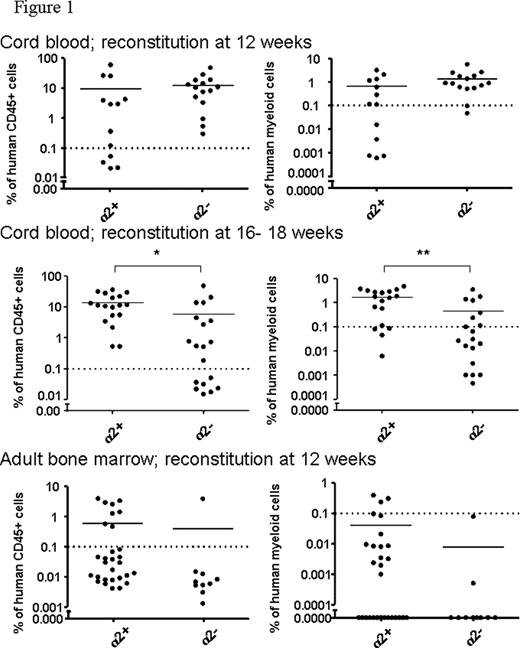Abstract
Abstract 2609
Human primitive stem cells reside in the CD34+CD38- fraction in cord blood and bone marrow. However, there is a high level of heterogeneity in these cell fractions, and the phenotype of the rare primitive stem cells remains poorly defined. We have studied expression of integrin alpha2 chain, a member of a family of beta1 integrin cell adhesion receptors, in CD34+CD38- cells in adult bone marrow and cord blood. >90% of bone marrow CD34+CD38- cells and >95% of CD34+CD38-CD90+ cells, enriched in long-term in vivo reconstituting stem cells (Majeti et al., Cell Stem Cell 1:635, 2007) expressed the integrin alpha2 chain. In contrast, in cord blood CD34+CD38- and the CD34+CD38-CD90+ subpopulation, the integrin alpha2 chain was expressed only in 37.1+/− 5.3% and 32.2+/− 4.9% of the cells (mean+/− SD), respectively. To determine whether integrin alpha2 expression could be used to identify functionally distinct stem and progenitor cell populations in cord blood and bone marrow, we isolated CD34+CD38- integrin alpha2+ and alpha2- cells by flow cytometry and analyzed these by in vivo transplantation into immunodeficient NOD/SCID-IL2Rgammacnull (NSG) mice and by in vitro progenitor cell assays (long-term culture initiating cell, LTC-IC, and colony assays). Transplantation of cord blood CD34+CD38- integrin alpha2+ cells resulted in significantly higher level of human CD45+ (p<0.05), myeloid (p<0.01) and CD34+ (p<0.05) cell engraftment at 16–18 weeks after transplantation than integrin alpha2- cells (reconstitution/300 cells in age and sex matched recipients, Figure 1). In contrast, there were no differences in reconstitution at 12 weeks in mice transplanted with cord blood CD34+CD38- alpha2+ and alpha2- cells. Because of lower engraftment capacity of adult bone marrow cells in immunodeficient mice, bone marrow CD34+CD38- cells were analyzed after intra-bone transplantation. After 12 weeks only few mice transplanted with the CD34+CD38- integrin alpha2+ cells but none transplanted with the corresponding alpha2- cells were reconstituted with human CD45+ or myeloid cells at a level '0.1%. The LTC-IC progenitors within the CD34+CD38- populations, assayed after 6 weeks culture on stroma, in adult bone marrow were highly enriched in the alpha2+ as compared with alpha2- fraction (mean +/− SD 96.7+/− 57.0 and 0.2+/− 0.6 colonies/50 cells, respectively), whereas in cord blood they resided equally in both integrin alpha2+ and alpha2- cell fractions (mean +/− SD 77.4+/− 59.4 and 108.8+/− 96.0 colonies/50 cells, respectively). The lineage committed CFU-GM and BFU-E progenitors in adult bone marrow were within integrin CD34+CD38- alpha2+ and alpha2- fractions (mean +/− SD 8.5+/− 5.3 and 14.9+/− 16.2 colonies/100 cells, respectively), whereas in cord blood they were significantly enriched in the alpha2- fraction (mean +/− SD 9.3+/− 5.5 and 22.0+/− 6.7 colonies/100 cells in alpha2+ and alpha2- fractions, respectively). Taken together, our results show expression of integrin alpha2 receptor in most of the primitive cord blood long-term in vivo reconstituting stem cells, with a gradual loss of the integrin alpha2 receptor during maturation to short term in vivo reconstituting stem cells, LTC-IC and lineage committed progenitors. Furthermore, our findings show distinct ontogeny-related differences in the expression of the integrin alpha2 receptor in the functionally defined primitive and lineage-committed CD34+CD38- progenitors, indicating differences in cellular interactions of cord blood and bone marrow progenitors with the hematopoietic niches.
Ekblom:Bristol-Myers Squibb: Honoraria.

This icon denotes an abstract that is clinically relevant.
Author notes
Asterisk with author names denotes non-ASH members.


